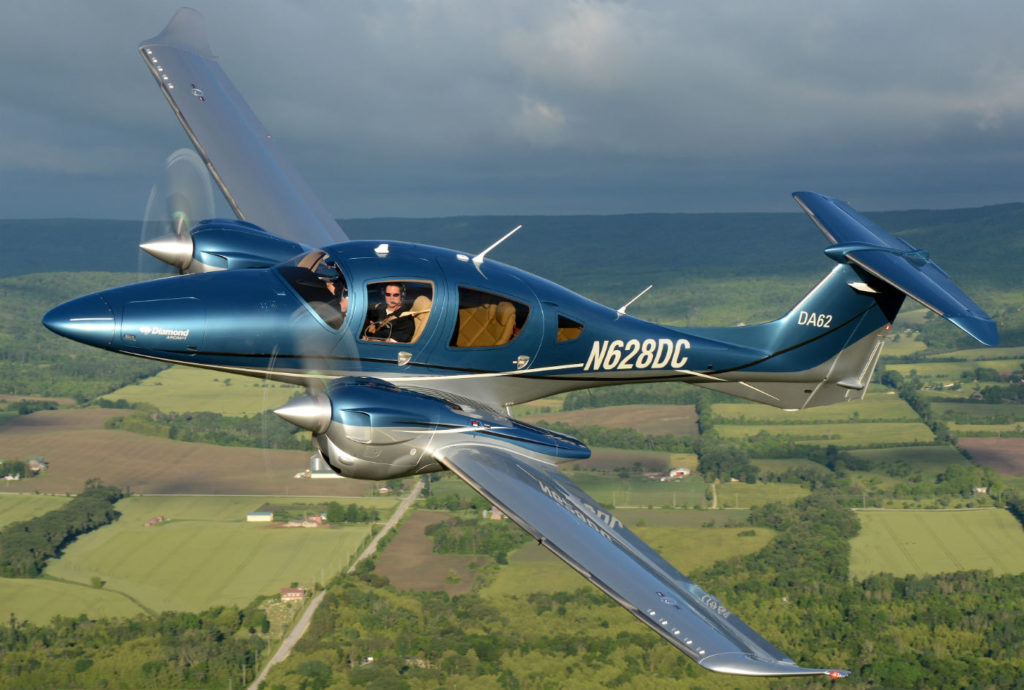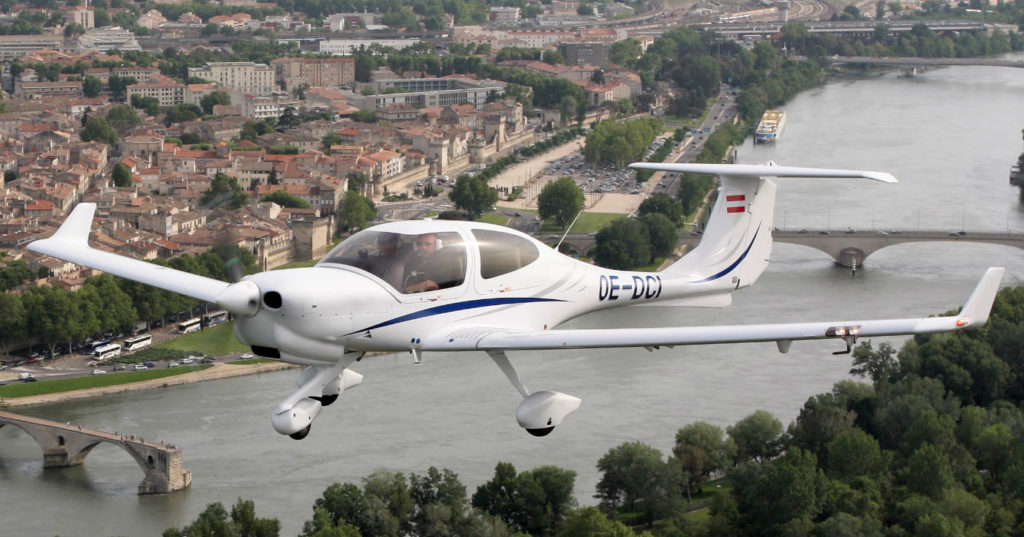Estimated reading time 9 minutes, 12 seconds.
It has been building composite general aviation aircraft for flying schools and private use in London, Ont., for 25 years, but now Diamond Aircraft Industries (Diamond Canada) is poised for renewed growth.

As a brand, Diamond Aircraft is the third-largest manufacturer of piston aircraft in the world after Cirrus Aircraft and Textron Aviation (Cessna and Beechcraft), but it isn’t as well-known as other aerospace companies.
“We’ve been flying under the radar,” observed Diamond Canada CEO Peter Maurer. “Many people are surprised to learn that we have assembled more than 2,000 aircraft in London since we opened in 1992; or that every pilot (and navigator) joining the U.S. Air Force has received initial flight screening (IFS) on a Canadian-built Diamond DA20C-1 since at least 2006.”
Last December, the picture began to change when Wanfeng Aviation (part of Wangfeng Auto Holdings Corp., a Chinese conglomerate) bought a controlling share of Diamond Canada for an undisclosed amount.
The new investment is transforming Diamond Canada into an original equipment manufacturer (OEM) that owns the intellectual property rights and type certificates to all the aircraft it builds, said Maurer.
That’s good news for Diamond Canada, London, and the Canadian aerospace industry, since it will increase employment and aircraft exports.
In January, teams from London started commuting to Diamond Aircraft Industries GmbH (Diamond Austria) at Wiener Neustadt Airport in Vienna, Austria, to transfer production knowledge and tooling for two aircraft to Canada: the diesel powered four-seat Diamond DA40 NG single, and the seven-seat DA62 twin.
“In parallel, we are also transferring the design responsibility for both aircraft types from Austria to Canada and converting the EASA [European Aviation Safety Agency] type certificate to Transport Canada authority,” said Maurer. “This is a very complicated and bureaucratic process but as you go through it step-by-step everything will come together as you tick off all the boxes.”
Diamond Canada already owns the type certificates for the DA20-A1 and DA20-C1 trainers developed in Canada, which provides a good foundation for expansion.
In June, the first Canadian-assembled DA40 NG powered by a four-cylinder Austro Engine AE300 diesel flew for the first time at London Airport and assembly of the first of six DA62 kits from Austria was underway. Production tooling for the DA62 airframe will be installed during the plant shutdown in August to facilitate full-scale DA62 production by year-end.
The luxurious IFR DA62 twin fills the gap between high performance piston singles and entry-level single turboprops and is also aimed at the light charter market.
The DA62’s twin 180-horsepower Austro AE330 diesel engines have comparable total fuel consumption to high performance singles (i.e. the Cirrus SR22 or Cessna TTx) resulting in low operating costs and twin engine safety, added Maurer.
The DA40 is the second most popular four-seat single in its class (after the Cessna 172) with more than 1,000 Lycoming IO-360 powered models built under licence in Canada since 2002, after the first 150 were built in Austria.
Diamond Austria has exclusively built diesel DA40s since 2002. The first was the DA40 TDI powered by a 135-horsepower Thielert Centurion, but when Thielert became insolvent in 2008 Diamond invested heavily in the development of the 170-hp Austro Engine AE300 (based on the Mercedes Benz OM640 car engine) to power the DA40 NG and DA42 NG, introduced in 2010.
Diamond was “first to market” with a diesel single (DA40) and twin (DA42), which have proven popular in Europe and many regions of the globe where avgas is very expensive or unavailable.
Now, Diamond Canada will build DA40s with Lycoming and Austro engines on the same production line. Once the DA40 type certificate moves to Canada it will also be easier to upgrade the Lycoming DA40 with the new Garmin G1000NXi integrated avionics system found on the DA40 NG.
The recent introduction of the diesel Cessna Skyhawk JT-A and Piper Archer DX powered by a Continental CD-155 engine (based on the Thielert Centurion) doesn’t worry Diamond, which is also supporting DA42 customers who want to upgrade from the Thielert to the CD-155 using a supplemental type certificate (STC).

“We now have new competitors, but a rising tide floats all boats,” said Maurer. “The introduction of these new diesel aircraft will help increase market acceptance of our diesel models.”
Diamond reached peak aircraft production in 2007, when the Canadian factory produced an astonishing 296 (63 per cent) of 471 Diamond aircraft delivered, to capture an 18 per cent share of the 2,675 piston aircraft sold, according to the General Aviation Manufacturers Association (GAMA).
At the time, the London plant was delivering DA20-C1, DA40, DA40 FP (fixed pitch propeller) and DA42 aircraft, primarily to U.S. customers.
Then Diamond was hit by a “perfect storm” that included a 70 per cent drop in worldwide piston aircraft sales combined with a global economic crisis, the Thielert insolvency, and high capital expenditures associated with the D-Jet program, which had to be put on hold.
That’s when almost every piston engine aircraft manufacturer except Diamond went through a restructuring or ownership change (i.e. Beechcraft, Cirrus, Columbia, Mooney and Piper).
Diamond stepped forward and invested millions of euros in the falling market to certify its Austro engine as a Thielert replacement, both for new production aircraft and as a retrofit. The Canadian plant focused on preserving cash flow and diversifying its business.
Today, the London factory does contract work for Northrop Grumman (Northrop Grumman owns a DA52 X1/DA62 prototype) and with Dornier Seawings, which received the first Canadian-made composite centre fuselage and prototype wing for the new Dornier Seastar CD2 prototype at Oberpfaffenhofen airport, Germany, in early 2017.
Employment in London will nearly double to about 250 people in the next year as Diamond ramps up production and takes over new engineering, quality, sales, marketing and product support roles. A job fair was held in late June, with many open positions remaining to be filled, but the foreseeable future will not see the levels of 2007 to 2008 when 600 people worked there before the market crash.
“We need to grow prudently as we coordinate production, employment and market ramp-up,” cautioned Maurer. “I expect that given the current market, we should be able to reach and sustain one DA62 per week and two DA40s per week within a few years. Of course, we will try to expand beyond this as we develop new markets and especially fleet customers.”
Diamond Canada is a vertically integrated company where fibreglass and carbon cloth are combined with epoxy resin to create laminated and bonded components, which are corrosion resistant and have a better strength-to-weight ratio than aluminum. The result is stronger structures and higher aerodynamic efficiency, for better performance and fuel efficiency.
The company employs a wet layup technique where fibreglass or carbon cloth is pre-impregnated (prepreg) in a CNC laminating machine that applies an exact amount of epoxy resin immediately before layup in a mold. High load areas are reinforced with additional layers for extra strength.
All parts are vacuum-bagged and pre-cured in an oven at 60 C (140 F). Fuselages are made in one-piece right and left halves and after bonding of internal structure they are joined in the moulds for precise alignment. All composite parts are returned to an oven for post-cure at up to 80 C (175 F) for 18 hours.
The Canadian and Austrian factories will continue to work together and share the same international distribution network, said Maurer.








